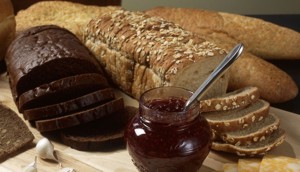High triglyceride levels often mean increased risks of cardiovascular disease and stroke. Lower your triglycerides with these 5 simple diet and lifestyle changes.
| Get More Omega–3s
Not all fat is bad fat. While you're working on reducing triglycerides, you should also focus on increasing healthy omega–3 fats. Omega-3's are actually good for your heart and especially effective at lowering triglyceride levels. I recommend eating at least two servings of omega–3–rich fish, such as wild salmon, herring, mackerel (though not king), sardines, rainbow trout, or even Pacific oysters, each week.If you are not going to be diligent about eating these fish twice a week EVERY week, speak with your doctor about incorporating fish oil supplements into your routine.I use Shaklee OmegaGuard because it is guaranteed to be tested and free of heavy metals that have recently been appearing in some other brands.
Maintain a Healthy Weight
If you're overweight, you are at a greater risk for high triglycerides, but simple lifestyle changes like following a balanced diet, incorporating healthy meal replacement shakes and exercising can help you lose weight and lower your triglyceride levels. Cut down on high–calorie foods and beverages and make it a priority to incorporate more vegetables and fruits into your diet. They're low in calories to help you achieve your weight loss goals, and packed with nutrients to improve overall heart health.
Reduce Unhealthy Fats
Our bodies store and circulate fat in the form of triglycerides. Eating a diet heavy in saturated and trans fats will raise the levels of your blood triglycerides. Fortunately, you can markedly improve your triglyceride levels by cutting down on consumption of these unhealthy fats and increase coconut oil in it's place. If you have high triglycerides, it's especially important to cut the saturated fat, including marbled red meat, poultry skin, butter, whole milk, and other full–fat dairy products. Since trans fats are even more harmful than saturated fats, you'll want to carefully check nutrition labels on margarines, snack foods, baked goods, and other packaged items to ensure they don't contain any trans fats.
Limit Refined Carbs
Low quality carbs (foods high in sugar or refined grains like white flour) can cause a sudden rise in your body's insulin, which can lead to a spike in triglycerides. To lower your triglyceride numbers, you'll need to dramatically limit your intake of sugary and refined carbs including sugar, honey, and other sweeteners, white rice, white bread, regular white pasta, and other foods that have been made with white flour (also called enriched wheat flour or all-purpose flour), including many cookies, cakes, breakfast cereals, crackers, and snack foods, candy, baked goods, and anything made with white (refined or enriched) flour. You'll also want to limit dried fruit and fruit juice since they're dense in simple sugar. Instead aim for high–quality carbs — vegetables, fruits, and whole grain foods like oatmeal, healthy cereals, brown
Drink Less Alcohol
If you have high triglycerides, alcohol should be considered a rare treat — if you indulge at all, since even small amounts of alcohol can dramatically increase triglyceride levels. In sensitive individuals, just one drink can send triglycerides soaring. When you're out at social occasions, consider ordering a flavorful spritzer made with seltzer water and a splash of fruit juice. It'll be healthier for you — and no one has to know that there isn't any alcohol in it.
|





 Due to the growing awareness of celiac disease and gluten-intolerance, food manufacturers, supermarkets and health-food stores are stocking the shelves with gluten-free products. There is an increasing selection of gluten-free cookbooks and gluten-free websites of information. You can follow a gluten-free lifestyle and it is becoming increasingly easier and more convenient to do it.
Due to the growing awareness of celiac disease and gluten-intolerance, food manufacturers, supermarkets and health-food stores are stocking the shelves with gluten-free products. There is an increasing selection of gluten-free cookbooks and gluten-free websites of information. You can follow a gluten-free lifestyle and it is becoming increasingly easier and more convenient to do it.